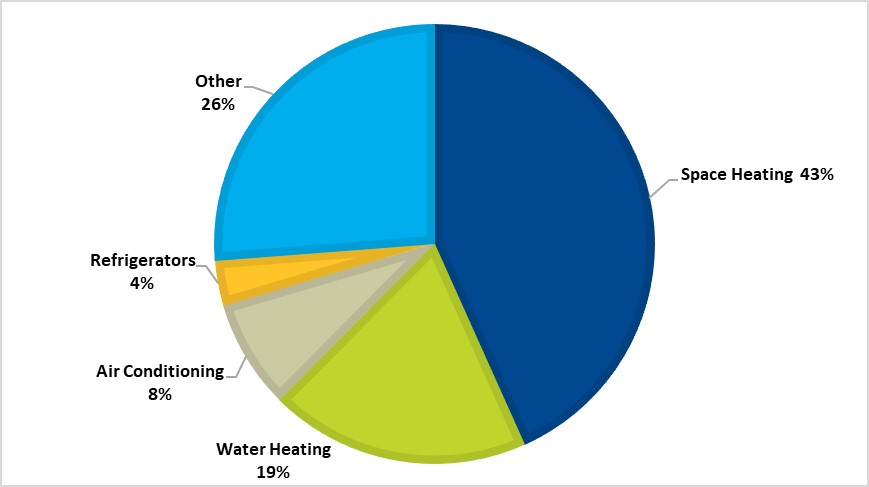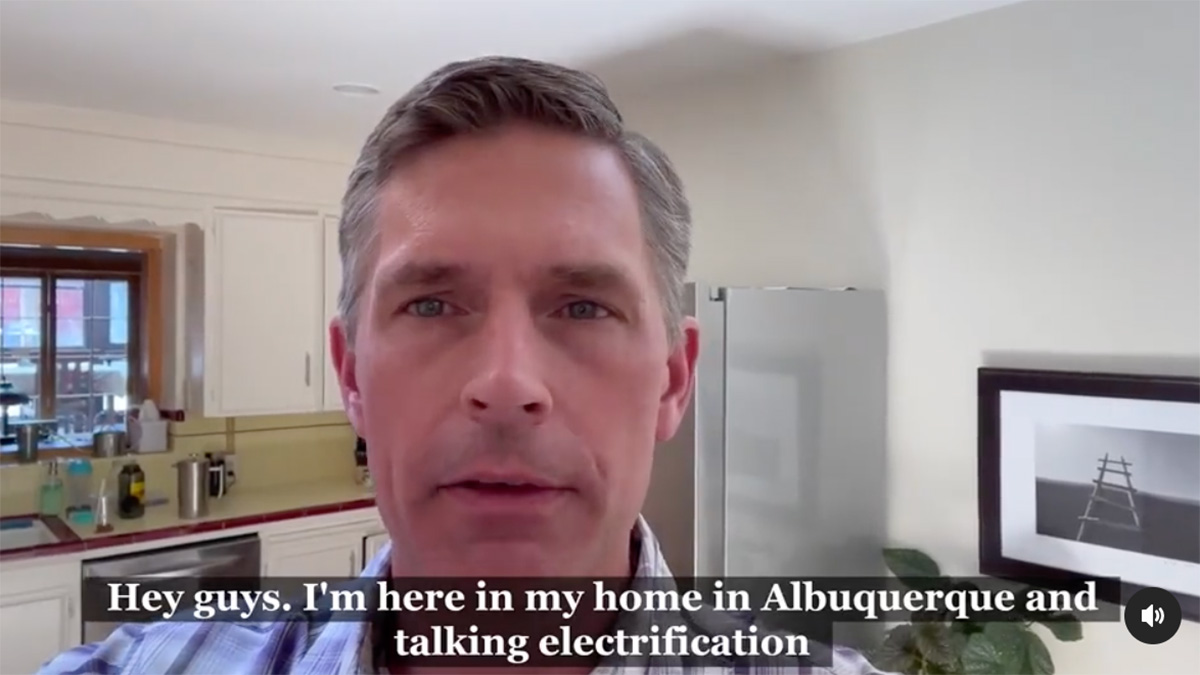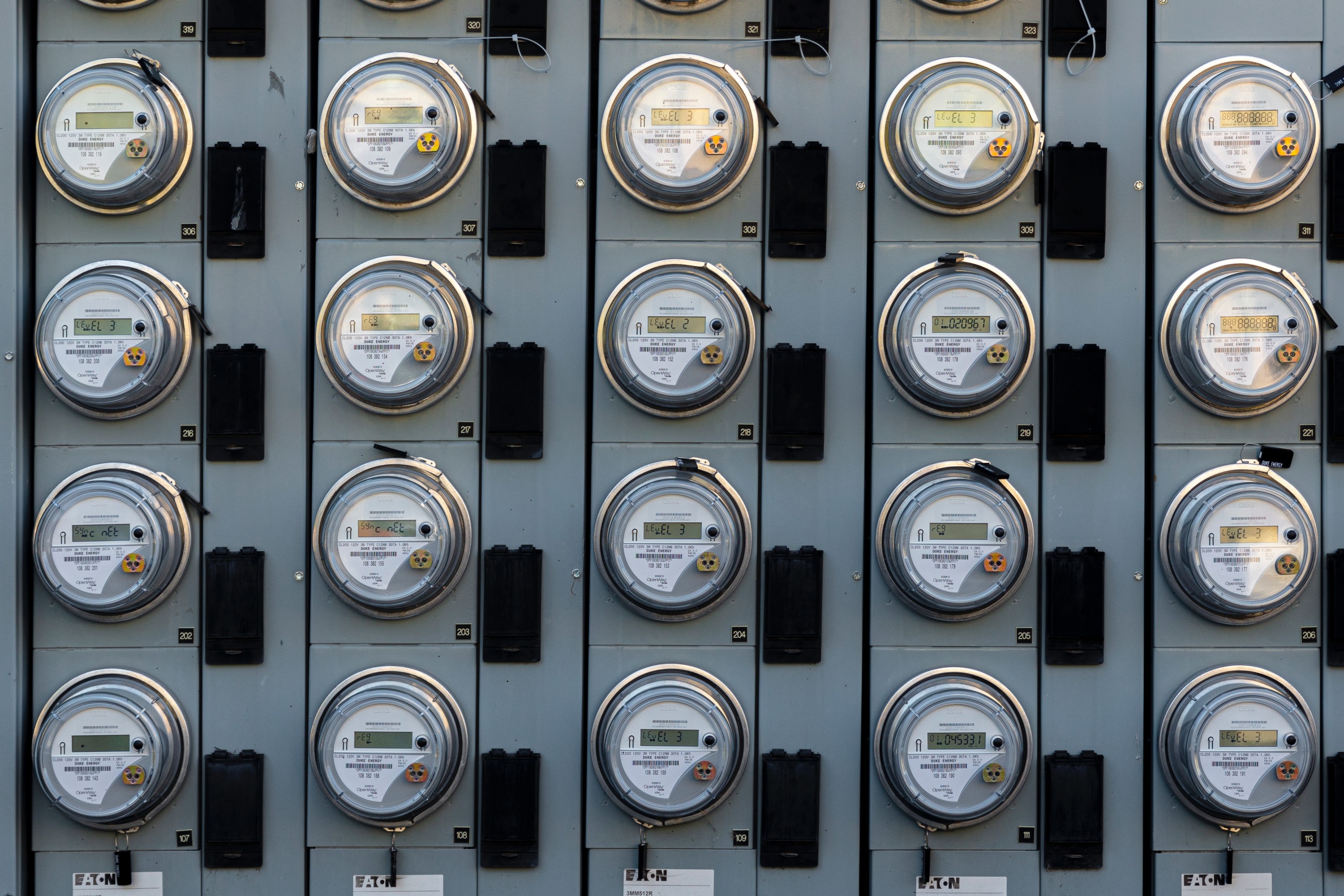
Electric Buildings
How to repower where we live, work and learn with clean energy
To prevent air and water pollution and the worst impacts of global warming, America must move toward meeting its energy needs with 100 percent renewable energy. Getting there will require that we get the most out of every bit of energy we use – and that we end the burning of fossil fuels in our homes and commercial buildings.
Downloads
To prevent air and water pollution and the worst impacts of global warming, America must move toward meeting its energy needs with 100 percent renewable energy. Getting there will require that we get the most out of every bit of energy we use – and that we end the burning of fossil fuels in our homes and commercial buildings.
Wind and solar power are rapidly replacing dirty fossil fuels like coal as leading sources of our electricity.[1] As our electricity grid becomes cleaner, replacing the direct burning of fossil fuels like gas, heating oil and propane in our buildings will reduce climate change and air pollution.
New and improved technologies are putting clean, efficient electric space heating, water heating and appliances within the reach of most American households. Unfortunately, common barriers, including knowledge gaps and high upfront costs, often make the decision to switch from fossil fuels to electricity challenging for many homeowners and businesses.
Local, state and federal governments should take the next step toward repowering America with 100 percent renewable energy by accelerating the transition of our homes and businesses away from fossil fuels and toward electric power. Adopting smart public policies to encourage electrification of buildings, energy efficiency improvements, and installation of distributed renewable energy sources such as solar photovoltaic panels and solar hot water systems can help the nation to achieve the goal of ending the direct burning of fossil fuels by mid-century.
Fossil fuel burning in homes and businesses contributes to global warming and harms our health.
- Three out of every four American homes use fossil fuels directly for space heating, water heating or appliances.[2] Direct burning of fossil fuels accounts for more than half of all energy used in homes and at least 34 percent of all energy used in commercial buildings.[3]
- In 2017, fossil fuel combustion in U.S. homes and businesses produced 533 million metric tons of greenhouse gases[*], accounting for 8 percent of total U.S. greenhouse gas emissions and equivalent to the emissions of over 115 million cars.[4]
- A 2017 National Renewable Energy Laboratory (NREL) study estimates that full electrification of buildings could cut non-electrical uses of fossil fuels in the United States by more than one-fifth by 2050.[v]
- Burning fossil fuels within our homes creates indoor air pollution, which contributes to the development of respiratory diseases, heart disease and cancer.[vi]
Electric technologies can repower America’s buildings and open the door to renewable energy. Today’s electric technologies can meet nearly all our home and business energy needs – and often do so at a competitive cost and with a fraction of the pollution caused by fossil fuel combustion.

Figure ES-1: U.S. Residential Energy Consumption by End Use [vii]
- Space heating – Electric heat pumps, which pull heat from the air and ground and move it around a building, have improved dramatically in recent years.[viii] Geothermal heat pumps function well in all climates, and air-source heat pumps can now function effectively down to -12°F.[ix] Air-source and geothermal heat pumps are several times more efficient than gas and oil heating systems and can meet both heating and cooling needs in homes and commercial buildings.[x]
- Water heating – Heat pump, electric resistance and solar thermal water heaters can all heat water without the direct use of fossil fuels. New technologies are making electric technologies more efficient and cost-effective. Water heat pumps can be up to five times as efficient as a gas-powered water heater.[xi]
- Appliances – Highly efficient electric appliances can replace fossil-fueled versions and are often more effective. Electric induction cooktops are faster, cleaner, more precise and safer than a gas range.[xii]
Building electrification often makes sense for consumers.
- Electric heat pumps are already cost-effective for new construction and for some building retrofits.[xiii] One study found that heat pump installation during new construction reduced lifetime costs for consumers in several areas of the country – including “cold” climate zones.[xiv] In these new construction scenarios, consumers opting for heat pump installation over fossil fuel heating equipment can save between $2,000 and $13,700 for space and water heating over a 15-year period.[xv]
- Replacing an existing fossil fuel furnace with an electric heat pump is also financially beneficial in some circumstances.[xvi] Retrofitting a fossil-fuel furnace is most cost-effective when the fuel being replaced is either propane or fuel oil, and when both the furnace and the AC unit are at the end of their useful lives.[xvii]
- Building electrification allows building owners to take advantage of falling prices for clean electricity and benefit fully from installing solar PV panels or subscribing to community solar projects.[xviii] All-electric homes can meet much or all of their energy needs with solar panels – aiding homeowners financially and creating new opportunities for renewable energy.[xix]
Energy efficiency, energy storage and small-scale renewable energy technologies like solar power can help maximize the benefits of electrifying our buildings.
- Energy efficiency measures – such as reducing heating and cooling loads and installing high-efficiency systems – can save energy, money and ease the impacts on the electric grid from building electrification.[xx]
- Energy storage technologies, such as battery storage systems, energy management systems and demand response appliances enable homes and businesses to match electricity demand with the availability of low-cost, renewable energy.[xxi]
- Solar energy systems provide clean, stable, low-cost electricity, which can help offset the adoption costs of all-electric appliances. By electrifying buildings, homeowners and businesses can host more solar capacity, increase the share of solar electricity used on-site, and improve the value proposition of “going solar.”[xxii]
Common barriers – including lack of knowledge and insufficient incentives – are slowing the electrification of America’s buildings.
- Contractors are often unfamiliar with current technologies and foster a perception that electric heat pumps and other electric appliances are expensive and unreliable.[xxiii]
- Many consumers are not aware of improved technologies for electric heating and cooking – such as advanced heat pumps and induction cooktops – that overcome the limitations of previous generations of electric appliances.[xxiv]
- While falling prices have made electric systems an affordable and sustainable option for new buildings, the high capital costs associated with retrofitting buildings may mean that electrification is not always financially viable without substantial incentives.[xxv]
- Some energy efficiency programs offer minimal rebates or incentives for electrification and offer competing rebates for replacement of existing fossil fuel systems with more efficient versions, potentially slowing the transition to technologies that can be truly zero-emission.[xxvi]
- Concerns about the cost of electrification and about future demand on the grid may lead policymakers to take a “go slow” approach to electrification, despite the long lifetimes of fossil fuel energy systems and the pressing need to move to a 100 percent renewable energy system by mid-century.
Policymakers at the local, state and federal levels should implement policies to accelerate the transition from fossil fuels to clean electricity in our buildings.
- Ban fossil fuels in new construction. Electric heating and hot water systems are often cost-effective in new construction. Several cities, including San Jose, California, have used building codes to ban new buildings from using gas.[xxvii] Cities should require new buildings to be powered exclusively by electricity and use energy codes to encourage or require the development of zero net energy or zero net carbon buildings, which receive their energy from renewable sources.[xxviii]
- Implement rebate programs and low-cost financing. To alleviate the high upfront costs of building and appliance retrofits, policymakers should offer rebates, low-interest loans and innovative financing options to homeowners, contractors and builders for electric retrofits.
- Create and expand tax incentives for electrified buildings. Some tax breaks on the federal and state levels already exist for buildings that are energy efficient and/or utilize electric technology.[xxix] Several states have implemented property tax exemptions, which exclude any upgrades that homeowners make, such as a geothermal heat pump, from their property value for tax purposes.[xxx] The expansion of existing tax credits and exemptions, as well as the creation of new tax incentives specifically for the installation of electric technologies, could encourage more building owners to build or transition to fully electric systems.
- Require transparency about building energy use. Mandatory reporting about the energy source and performance of buildings helps ensure that any investments that owners make to improve efficiency and install electric systems are reflected in the building’s value. Austin, Texas and New York City, among other cities, require that every building complete an energy efficiency assessment and disclose the results prior to its sale.[xxxi]
- Educate developers, contractors and consumers about options for, and benefits of, electrification. Information is crucial for home and building owners to feel comfortable transitioning to fully electric systems. Government offices at the federal, state and local levels can help fill information gaps by posting materials online, launching public information campaigns, and establishing programs that help owners identify which electric appliances and systems are right for their buildings. Similarly, policymakers should encourage the creation of education and training programs for developers and contractors to familiarize them with modern electric heating, hot water systems, and sustainable design.
[*] Actual emissions associated with fossil fuel use in buildings are likely much higher, as this figure does not account for the impact of leaked methane during the production and transmission of natural gas.
[1] Rob Sargent, Jonathan Sundby and Gideon Weissman, Environment America Research & Policy Center and Frontier Group, Renewables on the Rise 2019, August 2019, downloaded at https://frontiergroup.org/reports/fg/renewables-rise-2019.
[2] U.S. Energy Information Administration, One in Four U.S. Homes is All Electric, 1 May 2019, archived at http://web.archive.org/web/20190923052739/https://www.eia.gov/todayinenergy/detail.php?id=39293.
[3] U.S. Energy Information Administration, Use of Energy Explained: Energy Use in Homes, 28 September 2018, archived at http://web.archive.org/web/20190925011236/https://www.eia.gov/energyexplained/use-of-energy/commercial-buildings.php; U.S. Energy Information Administration, Use of Energy Explained: Energy Use in Commercial Buildings, 28 September 2018, archived at http://web.archive.org/web/20190925011236/https://www.eia.gov/energyexplained/use-of-energy/commercial-buildings.php.
[4] Environmental Protection Agency, Greenhouse Gas Inventory Data Explorer, accessed on 18 October 2019, archived at https://web.archive.org/web/20191125132550/https://cfpub.epa.gov/ghgdata/inventoryexplorer/; total U.S. emissions: Environmental Protection Agency, Sources of Greenhouse Gas Emissions, accessed on 18 October 2019, archived at https://web.archive.org/web/20191125140351/https://www.epa.gov/ghgemissi… car equivalent: calculated by dividing 533 million metric tons by the EPA estimate for annual emissions from a typical passenger vehicle (4.6 metric tons). EPA source: U.S. Environmental Protection Agency, Greenhouse Gas Emissions from a Typical Passenger Vehicle, accessed on 10 October 2019, archived at https://web.archive.org/web/20191125140508/https://www.epa.gov/greenvehi….
[v] Fossil fuel use reduction: calculated by taking total estimated direct fossil fuel consumption in 2050 for transportation, industry and buildings sector (45.83 quads) and dividing by reductions in fossil fuel consumption in the buildings sector (10.23 quads); Source: Daniel Steinberg et. al, National Renewable Energy Laboratory, Electrification & Decarbonization: Exploring U.S. Energy Use and Greenhouse Gas Emissions in Scenarios with Widespread Electrification and Power Sector Decarbonization, July 2017, archived at https://web.archive.org/web/20190926165518/https://www.nrel.gov/docs/fy17osti/68214.pdf.
[vi] Environmental Protection Agency, Introduction to Indoor Air Quality, accessed on 19 September 2019, archived at http://web.archive.org/web/20190730141940/https://www.epa.gov/indoor-air-quality-iaq/introduction-indoor-air-quality; Heart disease and carbon monoxide: ScienceDaily, “Carbon Monoxide May Cause Long-lasting Heart Damage,”29 January 2008, archived at http://web.archive.org/web/20150711154139/http://www.sciencedaily.com:80/releases/2008/01/080129125412.htm; Nitrogen dioxide and heart disease: Thomas Bourdrel et. al, “Cardiovascular effects of air pollution,” Archives of Cardiovascular Diseases, 110(11):634-642, DOI: 10.1016, November 2017, archived at https://web.archive.org/web/20191125140646/https://www.sciencedirect.com… Respiratory function and gas cooking: D. Jarvis et. al, “The association of respiratory symptoms and lung function with the use of gas for cooking. European Community Respiratory Health Survey,” European Respiratory Journal, 11(3):651-658, March 1998, archived at http://web.archive.org/web/20190919192422/https://www.ncbi.nlm.nih.gov/p… Formaldehyde and cancer: Environmental Protection Agency, Facts About Formaldehyde, accessed on 19 September 2019, archived at http://web.archive.org/web/20191014212947/https://www.epa.gov/formaldehyde/facts-about-formaldehyde.
[vii] U.S. Energy Information Administration, 2015 Residential Energy Consumption Survey Data, 2017, archived at http://web.archive.org/web/20190630014648/https://www.eia.gov/consumption/residential/index.php.
[viii] U.S. Department of Energy, Heat Pump Systems, accessed on 11 October 2019, archived at http://web.archive.org/web/20191112070437/https://www.energy.gov/energysaver/heat-and-cool/heat-pump-systems.
[ix] Jacob Corvidae, Michael Gartman and Alisa Petersen, Rocky Mountain Institute, The Economics of Zero-Energy Homes, 2019, downloaded at https://rmi.org/insight/economics-of-zero-energy-homes/.
[x] Heat pump efficiency: Comfort365, Frequently Asked Questions, accessed on 19 September 2019, archived at https://web.archive.org/web/20191125141341/http://wepowr.com/bouldercomf… Gas and oil efficiency: Stafor, COP – Coefficient of Performance, accessed on 19 September 2019, archived at http://web.archive.org/web/20181021075929/http://www.stafor.lv:80/gb/ion….
[xi] Neil Kolwey and Howard Geller, Southwest Energy Efficiency Project, Benefits of Heat Pumps for Homes in the Southwest, June 2018, accessed at http://www.swenergy.org/data/sites/1/media/documents/publications/documents/Heat%20pump%20study%20FINAL%202018-06-18.pdf.
[xii] Paul Hope, Consumer Reports, Pros and Cons of Induction Cooktops and Ranges, 13 June 2018, archived at http://web.archive.org/web/20190910074118/https://www.consumerreports.or….
[xiii] Note: In many cases it can make sense to retrofit a building that uses an inefficient form of space heating – such as oil, propane of electric resistance. See Merrian Borgeson and Emily Levin, National Resource Defense Council, Driving the Market for Heat Pumps in the Northeast, 21 February 2018, archived at http://web.archive.org/web/20190723164707/https://www.nrdc.org/experts/merrian-borgeson/driving-market-heat-pumps-northeast.
[xiv] Surveyed cities were Oakland, CA, Houston, TX, Providence, RI and Chicago, IL. Climate zones were from Building America. Climate zones: See Figure 1, Michael C. Baechler, Theresa L. Gilbride, Pam C. Cole, Marye G. Hefty, and Kathi Ruiz, Pacific Northwest National Laboratory, Guide to Determining Climate Regions by County, August 2015, accessed at https://www.energy.gov/sites/prod/files/2015/10/f27/ba_climate_region_gu… Cities: Sherri Billimoria, Leia Guccione, Mike Henchen and Leah Louis-Prescott, Rocky Mountain Institute, The Economics of Electrifying Buildings, 2018, downloaded at https://rmi.org/insight/the-economics-of-electrifying-buildings/.
[xv] Sherri Billimoria, Leia Guccione, Mike Henchen and Leah Louis-Prescott, Rocky Mountain Institute, The Economics of Electrifying Buildings, 2018, downloaded at https://rmi.org/insight/the-economics-of-electrifying-buildings/. Note: The Rocky Mountain institute ran analysis of various new construction and retrofit scenarios in Oakland, CA, Houston, TX, Providence, RI, and Chicago, IL.
[xvi] Ibid.
[xvii] Eric Wilson, Craig Christensen, Scott Horowitz, Joseph Robertson, and Jeff Maguire, National Renewable Energy Laboratory, Energy Efficiency Potential in the U.S. Single-Family Housing Stock, December 2017, accessed at https://www.nrel.gov/docs/fy18osti/68670.pdf.
[xviii] Prices falling: Ran Fu, David Feldman, and Robert Margolis, National Renewable Energy Laboratory, U.S. Solar Photovoltaic System Cost Benchmark: Q1 2018, November 2018; Lazard, Levelized Cost of Energy Analysis Version 12.0, November 2018, archived at http://web.archive.org/web/20191013052337/https://www.lazard.com/media/4… John Weaver, “New record low solar power price? 2.175¢/kWh in Idaho,” PV Magazine, 27 March 2019, archived at http://web.archive.org/web/20191112024014/https://pv-magazine-usa.com/2019/03/27/idaho-seeks-record-low-solar-power-price-2-175%c2%a2-kwh/.
[xix] Cole Latimer, “Too Much of a Good Thing: Solar Power Surge Is Flooding the Grid,” Sydney Morning Herald, 6 June 2018, archived at http://web.archive.org/web/20180616065958/smh. com.au/business/the-economy/too-much-of-a-good-thingsolar-power-surge-is-flooding-the-grid-20180606-p4zjs7.html; Ivan Penn, “California Invested Heavily in Solar Power. Now There’s So Much That Other States Are Sometimes Paid to Take It,” Los Angeles Times, 22 June 2017, archived at http://web. archive.org/web/20181023024952/www.latimes.com/projects/ la-fi-electricity-solar/.
[xx] U.S. Department of Energy and Environmental Protection Agency, Energy Star, Energy Star Home Tips, accessed on 24 September 2019, archived at https://web.archive.org/web/20190809124344/https://www.energystar.gov/products/energy_star_home_tips.
[xxi] Energy storage: Arina Anisie and Francisco Boshell, International Renewable Energy Agency, Behind-the-Meter
Batteries, 2019, accessed at https://www.irena.org/-/media/Files/IRENA/Agency/Publication/2019/Sep/IRENA_BTM_Batteries_2019.pdf?la=en&hash=86DF5CFBEDB71EB9A00A5E3680D72D6E346BD23A; Demand response: U.S. Department of Energy, Benefits of Demand Response in Electricity Markets and Recommendations for Achieving Them, February 2006, accessed at https://www.energy.gov/sites/prod/files/oeprod/DocumentsandMedia/DOE_Benefits_of_Demand_Response_in_Electricity_Markets_and_Recommendations_for_Achieving_Them_Report_to_Congress.pdf.
[xxii] Elizabeth Noll and Meg Waltner, Natural Resources Defense Council, Strong U.S. Energy Efficiency Standards: Decades of Using Energy Smarter, 8 December 2014, archived at http://
web.archive.org/web/20170215172028/nrdc.org/resources/.
strong-us-energy-efficiency-standards-decades-using-energysmarter; see note 15.
[xxiii] Jeff Deason et al, U.S. Department of Energy, Electrification of Buildings and Industry in the United States: Drivers, Barriers, Prospects, and Policy Approaches, March 2018, archived at http://web.archive.org/web/20180516204646/http://ipu.msu.edu/wp-content/uploads/2018/04/LBNL-Electrification-of-Buildings-2018.pdf.
[xxiv] Ibid.
[xxv] Ibid.
[xxvi] David Roberts, “Most American homes are still heated with fossil fuels. It’s time to electrify,” Vox, 2 July 2018, archived at https://web.archive.org/web/20191125144755/https://www.vox.com/energy-an….
[xxvii] Emily Deruy, “San Jose set to become largest U.S. city to enact natural gas ban,” The Mercury News, 17 September 2019, archived at https://web.archive.org/web/20190917191322/https://www.mercurynews.com/2019/09/17/san-jose-could-become-largest-u-s-city-to-enact-natural-gas-ban/.
[xxviii] Zero Net Energy: Steven Winter Associates, National Institute for Building Sciences, Net Zero Energy Buildings, 2 August 2016, accessed at https://www.wbdg.org/resources/net-zero-energy-buildings; Zero Net Carbon: World Green Building Council, What is Net Zero? Accessed on 13 November 2019 at https://www.worldgbc.org/advancing-net-zero/what-net-zero.
[xxix] Federal: U.S. Department of Energy, Tax Incentives for Energy Efficiency Upgrades in Commercial Buildings, accessed on 24 September 2019 at https://www.energy.gov/eere/buildings/tax-incentives-energy-efficiency-upgrades-commercial-buildings; State: Tonya Moreno, The Balance, State Tax Breaks for Energy, 25 August 2018, archived at http://web.archive.org/web/20190502094500/https://www.thebalance.com/state-tax-breaks-for-energy-3193337.
[xxx] U.S. Department of Energy and North Carolina Clean Energy Technology Center, Database of State Incentives for Renewables and Efficiency, Renewable Energy Property Tax Exemption – Indiana, accessed on 9 October 2019 at https://programs.dsireusa.org/system/program/detail/54.
[xxxi] New York City: Yaniv Vardi, “Making Sense of Building Requirements and Opportunities in NYC,” Greentech Media, 4 October 2017, accessed at https://www.greentechmedia.com/articles/read/making-sense-of-building-requirements-and-opportunities-in-nyc#gs.6htw1r; Austin: City of Austin, Energy Conservation Audit and Disclosure Ordinance, 31 May 2019, accessed at https://austinenergy.com/ae/energy-efficiency/ecad-ordinance/energy-conservation-audit-and-disclosure-ordinance.
Topics
Find Out More


Clean cooking tips from Sen. Heinrich

Green schools guide
